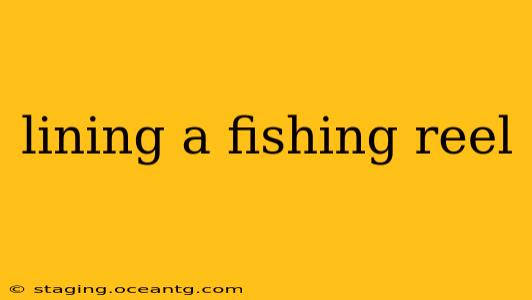Lining a fishing reel might seem daunting at first, but with the right technique and a little patience, it's a straightforward process that will significantly improve your fishing experience. This comprehensive guide covers everything from choosing the right line to mastering the spooling technique, ensuring your reel is perfectly set up for your next angling adventure. We'll also address common questions and troubleshooting tips to help you become a pro at lining your reel.
What Type of Fishing Line Should I Use?
The best fishing line for you depends heavily on the type of fishing you'll be doing. Consider these factors:
- Monofilament: This classic line is relatively inexpensive, strong, and has good knot strength. It's a great all-around choice for many anglers, especially beginners. However, it's susceptible to abrasion and can stretch more than other types.
- Fluorocarbon: Pricier than monofilament, fluorocarbon is nearly invisible underwater, making it ideal for clear water and discerning fish. It's also stronger than monofilament for its diameter and boasts superior abrasion resistance.
- Braided Line: Extremely strong for its diameter and boasts minimal stretch, braided line is a popular choice for anglers targeting larger fish or fishing in situations where sensitivity is paramount. However, it can be more abrasive on the guides and is generally more expensive.
Choosing the correct line weight (test) is also crucial. This refers to the line's breaking strength and should be matched to the size and species of fish you typically target. Consult your reel's specifications for recommended line capacity and diameter.
How Much Line Should I Put on My Reel?
The amount of line you should put on your reel is determined by the reel's capacity and the line's diameter. Most reels indicate the line capacity on the spool itself or in the manufacturer's specifications. Generally, you should aim to fill the spool to about 90% of its capacity. Overfilling can cause problems with casting and line management.
How Do I Properly Spool My Fishing Reel?
Here's a step-by-step guide on how to properly spool your fishing reel:
- Prepare the Line: Cut a length of fishing line, ensuring it's long enough to fill the spool.
- Attach the Line: Thread the line through the guides and tie a secure knot to the spool (Arbor Knot is a popular choice). Ensure the knot is tight and secure.
- Spool the Reel: Carefully and evenly spool the line onto the reel, applying consistent tension. Avoid over-spooling, which can create tangles and weak spots. A line-winding tool can be helpful for maintaining consistent tension.
- Check for Overlaps: After spooling, check for any unevenness or overlaps in the line. If present, carefully remove the line and repeat the spooling process.
How Do I Know If My Reel is Properly Spooled?
A properly spooled reel will have the line evenly distributed across the spool, with no gaps or overlaps. The line should sit flush against the spool, forming a smooth, flat surface. You should also be able to freely turn the handle without feeling any resistance or binding.
What are the Common Mistakes When Spooling a Fishing Reel?
Common mistakes include over-spooling, uneven line distribution, using the wrong type of line, and not applying enough tension. Over-spooling leads to poor casting and potential line breakage, while uneven distribution can create tangles and hinder performance. Using the wrong line diameter can impact casting distance and reel performance.
How Do I Fix a Bird's Nest in My Fishing Reel?
A "bird's nest" is a tangled mess of fishing line. While prevention is best (through proper spooling), sometimes it happens. Carefully untangle the line, working from the outside in. If you can't untangle it, cutting off the tangled section and re-spooling might be necessary.
This guide provides a solid foundation for lining your fishing reel. Remember, practice makes perfect, so don't be discouraged if your first attempt isn't flawless. With a little patience and attention to detail, you'll be confidently lining your reels and enjoying your fishing trips in no time.
